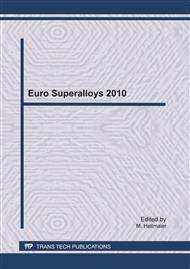p.306
p.312
p.321
p.327
p.333
p.339
p.345
p.351
p.357
Influence of Grain Boundaries on Short Fatigue Crack Growth in “Polycrystalline CMSX-4”
Abstract:
Increasing the resistance of a material to fatigue crack growth by optimizing the microstructure is a major task of materials science. In this regard, grain boundaries and precipitates are well known to decelerate short cracks. Thereby the strength of the interaction is influenced by the crack parameters crack length and distance to the obstacles, the grain boundary parameters like orientation of the adjacent grains and the precipitate parameters like size and distance. A comprehensive understanding of the underlying physical principles is missing. The focused ion beam (FIB) microscope offers new possibilities for systematic experiments and three dimensional investigations to quantify the microstructural impact. The ion beam is used to cut micro-notches as initiation sites for cracks. Contrary to natural cracks the influencing parameters can be varied independently for a systematic investigation of the mechanisms. Additionally, the ion beam is used to make a 3D image of the crack path and the surrounding microstructural elements. The commonly single crystalline nickel base superalloy CMSX-4 served as a model material in a polycrystalline modification. Thereby it was possible for the first time to reveal quantitative data of the effect of microstructural barriers on short fatigue crack growth.
Info:
Periodical:
Pages:
333-338
Citation:
Online since:
July 2011
Authors:
Permissions:
Share:
Citation:


